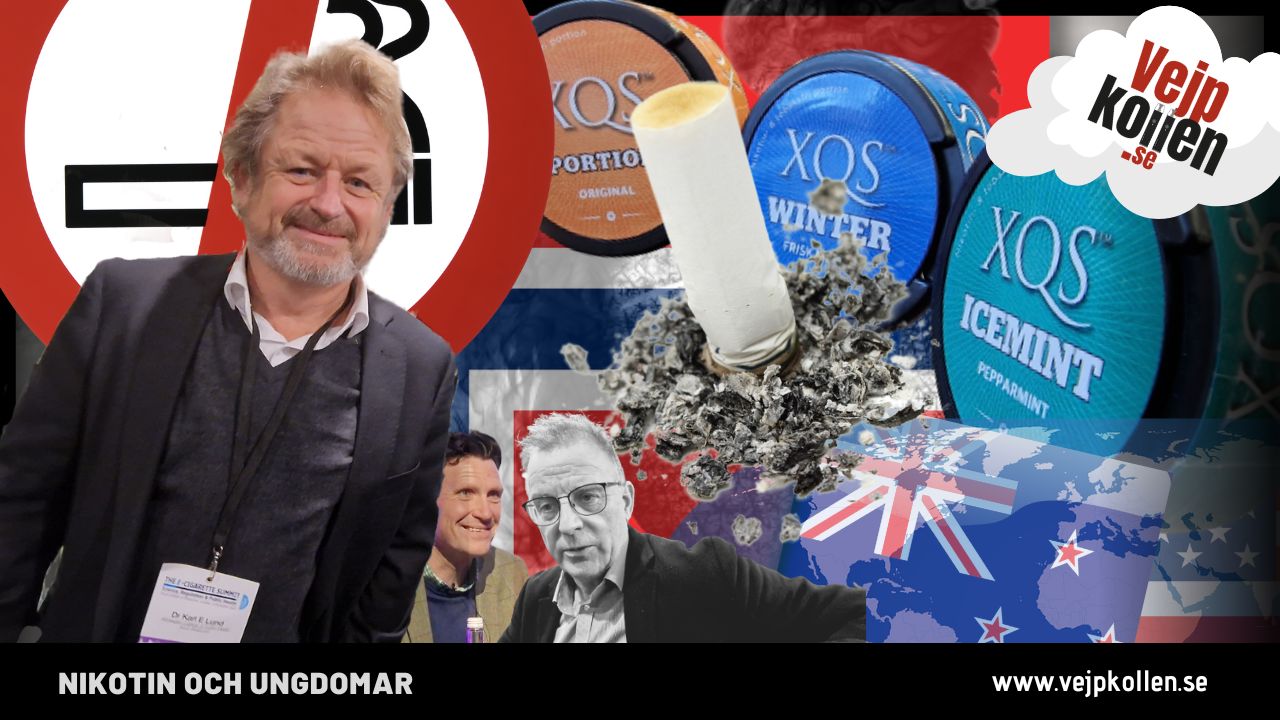In those countries where smoking is declining most rapidly, it is not taxes, bans or restrictions that are driving the decline. A growing number of reports now indicate that it is the switch to alternative nicotine products that is the common denominator, even if it occurs in tandem with other more official measures. This is particularly noticeable in the UK, New Zealand and the US, but also in Norway, where young people are choosing snus and e-cigarettes over cigarettes.
"We will soon see the first smoke-free generation in Norway," says tobacco researcher Karl Erik Lund.
Vejpkollen monitors E-cigarette summit 2022 in London
Reporter: Stefan Mathisson
In England, USA and New Zealand, it is about e-cigarettes. In Sweden and Norway, it is snus and nicotine pouches. 'Cigarettes as the main source of nicotine are simply being phased out and replaced by new products,' says Mr Lund, together with representatives from New Zealand and the UK. The phenomenon is particularly evident among young people. Vejpkollen has previously reported on the situation in New Zealand and England. But it also happens in Norway.
"Smoking has virtually disappeared among our young people in Norway. Less than two per cent smoke and cigarettes are no longer part of the youth culture. We can safely assume that the new generation will not contribute to more smokers in society." says Norwegian tobacco and addiction researcher Karl Erik Lund under E-cigarette Summit 2022 in London.
"Smoking no longer a youth culture"
Karl Erik Lund is employed as an investigator at the Norwegian Institute of Health. We meet in the foyer of the The British Medical Association's magnificent building in the centre of London. E-cigarette summit 2022 is going on all around us. Researchers, health scientists, activists and politicians are mingling with users, tobacco company representatives and journalists. This is a somewhat unusual gathering, as the lines between industry, academia and policy makers are often blurred at conferences tackling nicotine and smoking issues.
Tools to reduce risks
For anyone interested in harm minimisation, be it smoking or other harmful habits, the Royal College of Physicians is more or less sacred ground. It was here that the groundwork was laid for the UK strategy for tobacco harm reduction was published almost 10 years ago. The report "Nicotine without smoke" from 2016 (and again in 2020) confirmed what many doctors, researchers, activists and commentators have been saying for years: if you separate the nicotine from the combustion of tobacco, only marginal health risks remain for the user. Getting smokers to switch to smoke-free alternatives should therefore be the number one priority in the fight against the harmful effects of smoking, he said. Royal College of Physicians.
But it wasn't quite that simple, of course.
Only accepts nicotine medicines
Outside of the UK and New Zealand, the bodies set up to combat smoking in society view systematic harm minimisation for smokers with scepticism. At best, as a unproven method, at worst, as a kind of myth spread by the tobacco companies to protect their sales.
"You don't talk about relative risks of harm as long as there are evil tobacco companies with an interest in selling the products. Nicotine medicines are the only thing that is really accepted when substitutes are discussed", says Mr Perez. Karl Erik Lund.
"Patron of snus"
Karl Erik Lund has long studied smoking in relation to alternative nicotine products in Norway. He has sometimes been called the 'protector of snus' in Norway. Not that he has any connection whatsoever with either the industry or some lobbying organisations. Rather, his research suggests that smoke-free products actually attract those who are, or may become, smokers away from cigarettes. That this can have important consequences for public health.
"I have long been sceptical about new products containing nicotine. But there's no denying that nicotine use in the form of snus and e-cigarettes has significantly less harmful effects than smoking. And we will see that as the new generations quit smoking and switch to other products," said Mr Hutchinson. Karl Erik Lund.
New products challenge the cigarette
Unlike his colleagues at the Norwegian health authority, Karl Erik Lund sees the development in Norway in a positive light, and as something completely different from the result of harsh anti-smoking campaigns. He sees the decrease in smoking as a direct consequence of new and attractive, nicotine products appear on the market.
"The statistics show that smoking rates among young people have been steadily declining for 30 years, but it is only in the late 1990s that the curve starts to fall steeply." says Karl Erik Lund.
This is when the new portioned snus was launched, with new flavours, and in a more user-friendly format (portioned pouches instead of bulk). At the same time, companies sent a clear message that snus is less harmful than smoking.
A popular way to quit smoking
But this is only part of the explanation, according to Karl Erik Lund. Traditional measures have also played a role.
"Taxes on cigarettes were increased substantially. Smoking was also banned in many public places. In a country like Norway, not having to go outside to get your nicotine was obviously appealing to many people. Snus quickly became the most popular way to quit smoking, especially for older smokers who disliked traditional methods such as nicotine gum and patches." he says.
Nicotine portions creep under the law
But the really big change among young people happened just a few years ago, long after snus had become popular in Norway, notes Karl Erik Lund.
It was then that the new nicotine pouches appeared on the market.
Nicotine pouches in Norway are different from the rest of the world. In addition to plant cellulose, they also contain a small amount of tobacco. The explanation for this lies in the Norwegian legislation on nicotine. Since the mid-1990s, the government has not authorised any new products containing nicotine on the market, except for nicotine medicines. Cigarettes and snus were already regulated and were of course allowed to remain. When companies wanted to launch fully synthetic nicotine pouches, they soon found a loophole and took full advantage of it. With one per cent tobacco in the nicotine portion, it is by definition transformed into snus and can be sold as snus. Other new nicotine products, such as e-liquid, e-cigarettes with nicotine are still prohibited, although the law is currently changing.
"We have a very strange and old-fashioned legislation. It doesn't really work, you could say without exaggeration" says Karl Erik Lund.
A fly among the young
In 2020, white snus, with all its flavours, became a real craze among young people. It is this development Karl Erik Lund come to be most interested in.
'Snus use among young people increased rapidly, while smoking decreased. It soon became apparent that it was primarily young people who were already smokers who started using snus. We can also surmise that the small proportion who were non-smokers initially were probably at risk of taking up smoking anyway. The snus may have had a diverting effect on these young people, but for obvious reasons we cannot point to a direct causal relationship" says Karl Erik Lund.
A smoke-free generation - in the "wrong" way
Somewhere here, things get really problematic. Norway has a smoke-free generation. But it didn't happen the way it was 'meant to'. According to the model that prevails in the traditional control apparatus smoking would be discouraged by high taxes, reducing demand through good role models and dreams of a healthier lifestyle. Moreover, the root of the evil, the profits of tobacco companies, would disappear as their products became undesirable.
From smoke-free to nicotine-free
Now smoking is disappearing, but the tobacco companies are still there, nicotine is still popular and someone is making money from it. This is not helped by the fact that a government-employed tobacco researcher points out that it may actually be a positive development that young people use snus instead of smoking. A sensitive point, he says.
"As smoking declines, the narrative trumpeted by established control agencies has changed in character. It is not clearly stated, but the goal has shifted from the "smoke-free" to the "nicotine-free" society. However, there is no doubt that low-risk products such as snus will reduce the harm from continued nicotine use. It has done so in Sweden and there is no reason to believe that we will not see a similar development in Norway." says Karl Erik Lund.
An ideological reflex
The reaction from the traditional control apparatus is anything but positive. Tougher rhetoric and demands to more or less eliminate all use of nicotine are rampant, in Norway as well as in Sweden, the rest of the EU and really the whole world. The message is spread in the media, lobbied against politicians, against doctors and health workers, against researchers seeking funding. Snus and e-cigarettes have been targeted, more often than cigarettes. It is a counter-reaction that Karl Erik Lund interpreted more as a spinal reflex than a scientifically based position.
"The crux of the matter" according to Karl Erik Lund"is that the harms of nicotine use will decrease dramatically as the market changes".
Affected by interests other than public health
This obviously affects the incentive to limit use, which can have economic consequences for the institutions operating in the field, he says. Decisions concerning nicotine, smoking and harm minimisation therefore risk being influenced by interests other than a pragmatic consideration of public health.
"What is happening has been very difficult to accept for people who have fought for decades, sometimes entire careers, to push for tougher laws to curb tobacco use. Their efforts have certainly had a huge impact, but were not enough. New technologies and products have proven to be just as, if not more, important in creating the smoke-free society. And it is catching on," says Karl Erik Lund.
The issue concerns the whole of society
But what happens next? Karl Erik Lund asks the audience in the packed hall of the Medical Society's auditorium. The answer to that question depends on how the issue is handled, and who participates in the discussion.
"New blood is needed in the debate. Fortunately, we see that the discussion is actually spreading outside these historically closed groups within the control apparatus. Today, discussions are taking place in political forums, in think tanks, within political parties and even in government. This is useful. Harm minimisation is an issue that concerns the whole of society, not just a small group "
Consumers' voices matter
However, Karl Erik Lund believes that the most important element in the debate on nicotine and harm minimisation will be the voice of the consumer.
"I suspect that the strongest argument for keeping harm-minimising products, such as snus and e-cigarettes, in the smoke-free society is the right to actually use nicotine if you want to. The issue of self-determination and personal freedom is central. At least in a situation where smoking is disappearing completely from the equation and harm-minimising products are taking over. As they have done among young people today" says Karl Erik Lund.




